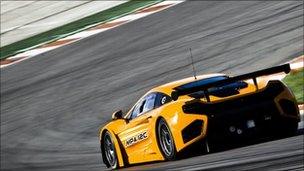McLaren launches GT3 racing car
- Published
Watch: Jorn Madslien takes a look at the MP4-12C
Formula 1 company McLaren has unveiled a racing version of a road car for the first time since 1997.
McLaren will enter the car in GT3 races this year.
The decision to return to endurance racing was sudden.
"Twelve months ago we weren't even discussing going racing," McLaren Automotive's chief test driver, Chris Goodwin, said.
In spite of this, the decision did not come as a big surprise, given that the company's new sports car - the MP4-12C, which was unveiled a couple of years ago - will be delivered to customers within weeks.
"When you make a car that incorporates the DNA of McLaren ... inevitably it's going to go racing," said Martin Whitmarsh, chief executive of McLaren Group and the F1 team principal.
"If we didn't race it, others would, so the choice was quite straightforward - either we sell road cars and watch our customers convert them to race cars or we develop the race cars ourselves."
Different world
In accordance with the rules of GT3 racing, McLaren's beefy race car is a souped-up version of its road car, with which it shares both a carbon chassis and a V8 twin turbo engine.
At the back, there is a big wing and an aggressive looking diffuser. Up front the car is lower to reduce drag. Along the sides, racing-styled aeroblades channel more air in through the reshaped air intakes, offering additional cooling and downforce.
Yet it is only by getting into the car that the driver will enter a totally different world.
Unlike the road car, which offers comfort and luxury, the racing car is stripped of all features, consisting of little but a carbon seat and a steering wheel that has been lifted from the F1 cars driven by Jenson Button, external and Lewis Hamilton, external.
Watch: McLaren CEO Martin Whitmarsh: 'We're a passionate company and we like going racing'
Specially designed
The steering wheel should bring some of the Grand Prix magic to GT3 racetracks all over the world, according to Goodwin.
The buttons on the wheel help the drivers control the six-speed racing gearbox, which has been specially designed for endurance racing, he explained.
In fact, unlike GT3 rivals from other car makers, it is not just the company's Formula 1 simulator that has been used in the car's development. In addition, some of its parts, such as the wing and the diffuser, have been developed by F1 engineers.
"The processes, the engineering, the culture, the technology that we have within our group has obviously been incorporated within our GT car," said Whitmarsh.
None of this will guarantee the car any victories once McLaren takes it to races later this year, however.
GT3 racing is highly competitive, with national championships across Europe as well as several pan-European series.
Returning to Le Mans?
In spite of potential defeat with the GT3 car, the company is already preparing to get more deeply involved in other forms of GT racing, for instance by returning to the legendary Le Mans 24-hour endurance race held every year in France.

McLaren hopes its GT3 racing car will be good enough to win
"We'd like to be back there," said Whitmarsh.
"There are many types of GT racing. It is inevitable that we will have to go into some of those other categories."
GT racing has helped a string of car makers, such as Peugeot and Audi, bolster the image of their brands in recent years.
Whitmarsh acknowledged that seeing the company's GT3 car "racing and winning on the track" would inevitably help build the McLaren Automotive brand too.
But he insisted this was not the reason why the GT3 car was made.
"Every fortnight of every year, we are racing in front of hundreds of millions of people as McLaren in Formula 1, so we've got a fair amount of brand building going on," he says.